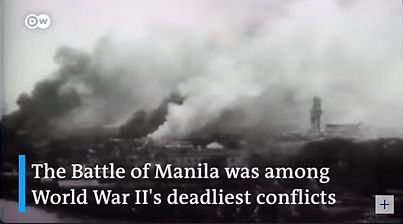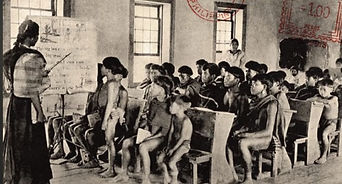American Colonial Period (1898-1946)
Step back in time to the American Colonial Era in the Philippines, a pivotal period that spanned nearly five decades. During this chapter of history, the Philippines underwent profound changes as it transitioned from Spanish rule to American administration. Explore the impact of foreign governance, cultural exchange, and the evolution of the nation's identity against the backdrop of a new era.
The Treaty of Paris (December 10, 1898)
The Treaty of Peace between the United States of America and the Kingdom of Spain, commonly known as the Treaty of Paris of 1898, was signed by Spain and the United States on December 10, 1898, that ended the Spanish–American War. Under it, Spain relinquished all claim of sovereignty over and title to territories described there as the island of Porto Rico and other islands now under Spanish sovereignty in the West Indies, and the island of Guam in the Marianas or Ladrones, the archipelago known as the Philippine Islands, and comprehending the islands lying within the following line to the United States. The cession of the Philippines involved a compensation of $20 million[a] from the United States to Spain.
click on the pic above to see the video
Emilio Aguinaldo officially declare war on US
(Feb 4, 1899)
On the night of February 4, 1899, shooting erupted on the outskirts of Manila. Morning found the Filipinos, who had fought bravely, even recklessly, defeated at all points. While the fighting was in progress, Aguinaldo issued a proclamation of war against the United States.
Battle in Manila, First and Largest battle of the war (February 5, 1899)
click on the pic above to see the video
Battle of Manila, (4–5 February 1899), largest and first battle of the Philippine-American War, a war between the United States and Filipino revolutionaries from 1899 to 1902, an insurrection that may be seen as a continuation of the Philippine Revolution against Spanish rule. Filipino hopes that the U.S. defeat of their Spanish colonial masters in the Spanish-American War of 1898 would bring independence to the Philippines were dashed when the United States annexed the islands for itself. The war began with a brief but bloody clash between Filipino independence fighters and U.S. troops in Manila.
America forces capture Malolos, the Capital
(March 31, 1899)
On March 31, 1899, during the Philippine-American War, American forces successfully captured Malolos, which was the capital of the First Philippine Republic at the time. This event marked a significant turning point in the conflict. Malolos was a strategic and symbolic target for the Americans, as it was not only the political center of Filipino resistance but also housed important government institutions. The American forces, under the command of General Arthur MacArthur Jr. and later General Frederick Funston, launched a well-coordinated assault on the city. Despite the formidable defense put up by Filipino revolutionary forces, American firepower and superior military tactics eventually overwhelmed them. The intense fighting and urban warfare led to significant destruction in the city.
Aguinaldo is captured by US forces, led by General Federick Funston (March 23, 1901)
On March 31, 1899, during the Philippine-American War, American forces successfully captured Malolos, which was the capital of the First Philippine Republic at the time. This event marked a significant turning point in the conflict. Malolos was a strategic and symbolic target for the Americans, as it was not only the political center of Filipino resistance but also housed important government institutions. The American forces, under the command of General Arthur MacArthur Jr. and later General Frederick Funston, launched a well-coordinated assault on the city. Despite the formidable defense put up by Filipino revolutionary forces, American firepower and superior military tactics eventually overwhelmed them. The intense fighting and urban warfare led to significant destruction in the city.
click on the pic above for more information
Aguinaldo makes peace with the US
(April, 1901)
Aguinaldo recognized the chance to advance the goal of Philippine independence through an alliance with the Americans. Following the resolution of hostilities with Spain, he declared the Philippines as an independent nation and assumed the title of president
Influences During the American Period
Religious Freedom
When the United States took over the Philippines, the people began to be free to join whatever religion they wanted. (During the Spanish rule, the Catholic church was established as the national religion and was strongly enforced). Because of this new found religious freedom, there began to be many different churches besides Catholicism. Today, it’s remarkable to see just how many different Christian churches there are in the Philippines – this religious diversity has become a big part of the culture.
Free Education
Americans introduced the idea of free education to the Philippine islands. The United States even sent teachers to help establish schools where the Filipino children could have a free education. A large group of these teachers were called “Thomasites,” named after the boat that they came on, called Thomas.
English
During this time, English began to be taught in the schools, and this is the language that the teachers would use. Even today, most Filipinos can’t help but mix in English words when they speak. “Taglish” has literally become part of the culture. In fact, English is now the 2nd national language. Lots of English words have made their way into the Tagalog language.During this time, English began to be taught in the schools, and this is the language that the teachers would use. Even today, most Filipinos can’t help but mix in English words when they speak. “Taglish” has literally become part of the culture. In fact, English is now the 2nd national language. Lots of English words have made their way into the Tagalog language.
click on the pic above to see the video
Infrastructures: public works and health systems
They set up essential public infrastructures: roads, bridges, ports, irrigation, water systems for public health. They hired local officials and induced local governments to perform their duties through directives from central bureaus run by American administrators. They hired capable locals in the central bureaus to help the colonial administrators. They improved public health through the eradication of disease and the improvement of public sanitation: waterworks, health centers, education.
Democracy and Civil Liberties
The American regime recognized the equality of men before the law and right of every man to all the freedoms- freedom of religion, freedom of speech, freedom of the press, freedom to complain and freedom to change one domicle (a place permanent residence).
Government System in the Philippines during American Period
Explore the administrative landscape of the American Colonial Period in the Philippines. During this time, a new governance structure emerged, shaped by American influences. Discover the changes, challenges, and innovations that defined the Philippine government system in this era.

As we conclude our exploration of the American Colonial Era in the Philippines, we reflect on an era of profound change and transformation. This period left an indelible mark on the nation's history, influencing not only governance but also culture, education, and more. The legacy of this era continues to shape the Philippines today, as it stands as a testament to resilience and adaptation in the face of challenges.

_edited.jpg)
_edited.jpg)
_edited.jpg)